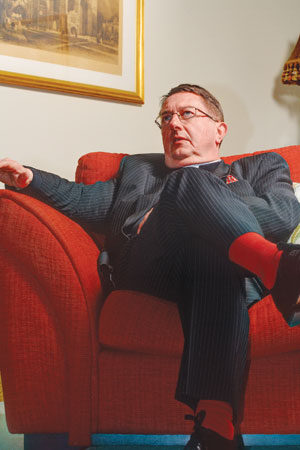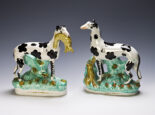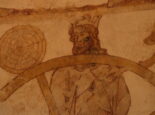Kingdom of Heaven | The Very Reverend Charles Taylor

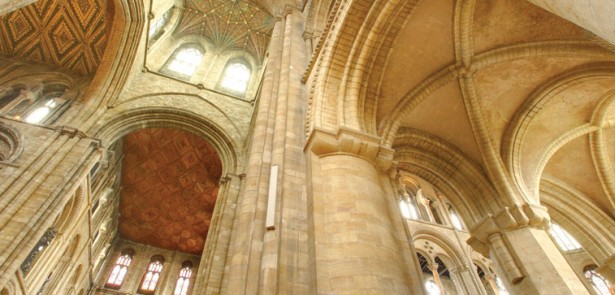
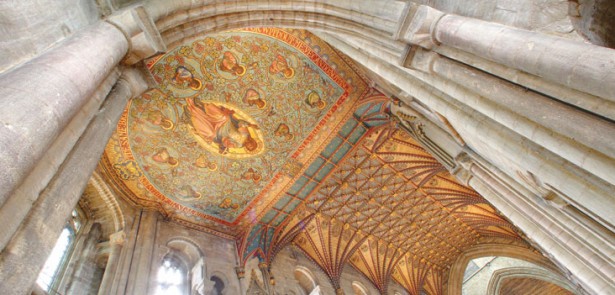
In many ways Peterborough Cathedral is Peterborough itself. It has stood as one constant in an ever-changing landscape for almost 900 years and it may just hold the key to the regeneration of a city which many feel has lost its way. But can the building that has been voted one of the UK’s top ten landmarks really help to defeat the “poverty of aspiration” that’s holding Peterborough back? The Very Reverend Charles Taylor, Dean of the cathedral, certainly thinks so.
There are few outward signs of the importance of the man who sits nursing a cup of coffee on a well-used armchair, gazing thoughtfully out over an oasis of greenery right in the heart of Peterborough city centre. He wears red socks, and a matching red handkerchief protrudes from the breast pocket of his dark suit. Amiable and welcoming, Charles Taylor even makes the coffee himself and serves it up in the spacious Victorian lounge that he only uses for entertaining guests. ‘We don’t have any domestic help’ he explains, ‘and the kids are all grown up and have left home so we prefer to live in the old servants’ quarters.’
Only the occasional white flash of a dog collar gives any clue as to the man’s profession and to the more exalted company he’s accustomed to keeping. He sang as a choir boy at Winston Churchill’s state funeral in St Paul’s Cathedral and at the memorial service for President Kennedy in the same building. He is a former chaplain of Westminster Abbey and was Resident Canon and Precentor of Lichfield Cathedral before moving to Peterborough to take up his post as Dean of the city cathedral four years ago. He may lunch with the Archbishop of Canterbury (eating for Jesus, as he calls it), Old Bailey judges, the Lord Mayor of London and other such luminaries, yet the Very Reverend Charles Taylor is not a pompous or stuffy man. He is clearly very intelligent, and not only on matters of religion, but he also has a keen sense of humour and is, refreshingly, in touch with the modern world. ‘We need to raise the cultural aspirations of the city beyond getting the quarter-final loser from The X Factor to switch on the Christmas lights’ he says when explaining the motivation behind a new music centre that’s to be built in the run up to the cathedral’s 900th anniversary in 2018.
Charles Taylor is a man on a mission, and his ideological goal is nothing short of the complete regeneration of Peterborough. ‘We need to tackle the poverty of aspiration that exists in Peterborough’ he says enthusiastically.
‘I think as a city we do run ourselves down too much. There’s fabulous diversity in Peterborough but it doesn’t have a very good image outside of the area. There are something like 40 languages spoken and over 100 nationalities represented here. That’s something that can either be seen as a problem or as a huge opportunity and I see it as the latter. Peterborough could be like Birmingham where there’s a jewellery quarter and a Polish quarter and a Chinatown – not as enclosed ghettos, but as places that are opened up to everyone to allow us to celebrate and share our diversity. That, to me, is what multi-culturalism is all about. That’s the sort of vision I have for the city.’
It’s no small aim, but then Charles Taylor didn’t rise to his considerable station by thinking small. To best explain the position of Dean of Peterborough Cathedral, he falls back on a naval analogy. ‘The bishop is the admiral of the fleet of the diocese – of all the little churches and parishes that are the ships in his fleet – and Peterborough Cathedral is his flagship. I’m the captain of that flagship.’
It’s a huge responsibility on many levels, and not least on a financial one. ‘There are different types of budget involved’ he says. ‘There’s a daily running budget, or what you might call the management accounts, and that’s in the region of £1 million per year. We employ our own staff, and house our own clergy and some of the staff, and we’re entirely responsible for the maintenance and operation of the building, and none of that money comes from wider church funds – we have to generate it. So the cathedral is financially independent from the rest of the Church of England. We put on events that we know are actually going to cost us money and those will be funded from other sources of income but I’m determined, for as long as we can resist it, not to charge for entry into the cathedral. Some cathedrals do – in fact most did until the 1920s – when it was recognised that it probably wasn’t the best way of encouraging the public to use them. But we have to make it clear to the public that if they want that situation to continue for future generations then any donation they can manage to give will help us to do that.’
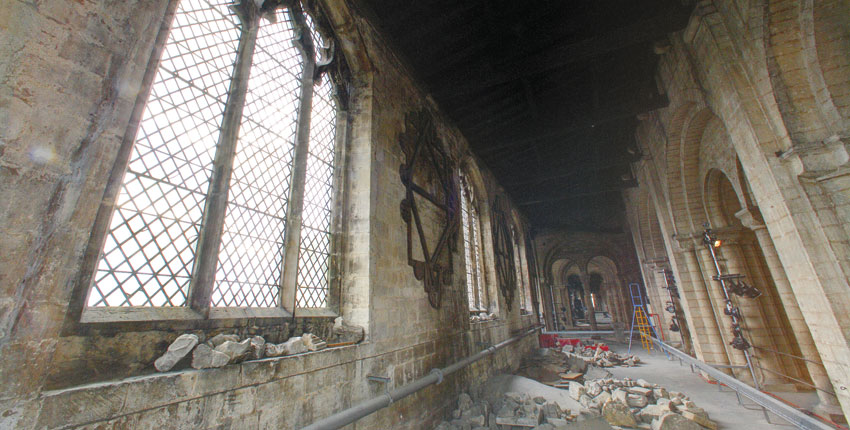 Maintenance projects are also hugely expensive and The Company of St Peter – the main fund-raising initiative for the cathedral – has raised an incredible £2,383,000 over the last ten years to help pay for these. And it’s not just centuries of wear and tear that necessitate maintenance projects; the cathedral faces far more immediate threats on occasion. Aside from a recent incident when a car driver crashed into the Norman gateway that leads into the precinct causing substantial damage, the cathedral came perilously close to being burned to the ground in 2001 as the Dean explains. ‘We think the fire was started by a mentally disturbed person lighting some candles under a stack of plastic chairs. We have the oldest painted wooden ceiling in Europe (13th century) which had to be completely restored following the fire when it suffered smoke damage. The heat became so intense the fire brigade said that within another half hour it would have gone into spontaneous combustion and the ceiling would have been lost.’
Maintenance projects are also hugely expensive and The Company of St Peter – the main fund-raising initiative for the cathedral – has raised an incredible £2,383,000 over the last ten years to help pay for these. And it’s not just centuries of wear and tear that necessitate maintenance projects; the cathedral faces far more immediate threats on occasion. Aside from a recent incident when a car driver crashed into the Norman gateway that leads into the precinct causing substantial damage, the cathedral came perilously close to being burned to the ground in 2001 as the Dean explains. ‘We think the fire was started by a mentally disturbed person lighting some candles under a stack of plastic chairs. We have the oldest painted wooden ceiling in Europe (13th century) which had to be completely restored following the fire when it suffered smoke damage. The heat became so intense the fire brigade said that within another half hour it would have gone into spontaneous combustion and the ceiling would have been lost.’
It would have been a monumental loss to the local community, not to mention the nation (the cathedral was voted one of the UK’s top ten landmarks in a Fujifilm poll in 2006, beating off such iconic buildings as Tower Bridge and Edinburgh Castle), to lose the building that has come to define the city. ‘It’s a regional icon’ says Taylor. ‘Images and sketches of the West Front appear on all sorts of company logos, even if they have nothing directly to do with the cathedral. But the cathedral says “Peterborough” and it really stands for something in the local community and beyond, to the point where it’s now a national icon.
‘Peterborough’s a great city but if you’re going to attract people to the place you need to have something they can identify with. Liverpool had The Beatles and The Cavern, Manchester has Old Trafford, so what would it be in Peterborough? It has to be the cathedral. It’s the icon of the city. So I think we should take every opportunity we can to put the place on the map – not just for the sake of the cathedral, but for the entire community.’
The role of Dean of Peterborough Cathedral has changed significantly over the centuries and promoting the city itself is now part of Taylor’s job description, something that would not have figured highly on the priorities of Taylor’s more distant predecessors. ‘The Dean, and the cathedral clergy as a whole, used to be seen primarily as thinkers, scholars and writers and, as long as you kept a roof on the place, you could spend your time producing learned tomes. But there’s simply not the leisure time to do that any more. You are now essentially managing a business and there’s all the associated bureaucracy that goes with that these days; making sure the accounts meet the standards of the charity commission, and dealing with all the paperwork and so on. But cathedrals are much more heavily engaged with their communities now and there’s a realisation that the clergy’s calling nowadays is to look outwards and engage with people and enable them to celebrate the faith story which is part of our heritage.’
Eating for Jesus
‘We can have up to 2,000 people visiting the house in the course of a year for various functions and myself and my wife Catherine do all the catering ourselves. A lot of my time is spent in the supermarket. I’m sure my wife thinks I’m having an affair with the checkout girl! And the checkout girl probably thinks I’m a party animal – I once had to buy 99 bottles of wine when we had a function for the new bishop’s installation. But we do all the cooking, serving up and the washing-up ourselves, sometimes for 40 guests. It’s just another part of my ministry.’
Over the last three decades, cathedrals across the country have thrown their medieval wooden doors open to the general community like never before, and it’s a philosophical shift that Taylor welcomes. ‘When I first started in the ministry 34 years ago, cathedrals were fairly enclosed institutions which, while not quite monastic, consisted of a collegiate community that got on with its daily rounds of worship and prayer. That still remains every cathedral’s prime purpose but unless you’re situated in a massive tourist area, Sunday congregations are really quite small, though in the last 20 years cathedrals have experienced enormous growth rates in their congregations and have become much more diverse communities. And I think it’s fair to say that the regular Sunday congregation here is probably the most diverse I’ve ever worked with in terms of age, ethnicity and social groupings.’
So why do so many people from such different backgrounds visit cathedrals? What do they get out of the experience? ‘It’s a very good question and you’d get as many answers as you would people’ Taylor says. ‘I think cathedrals to some extent stand as an icon of stability in an ever-changing world. That’s not to say they’re fossilised, but rather that there’s something there that has stood for a very long time. And I think we’re living in an age of inquiry where people are realising that perhaps there’s more to life than just the physical and material, though they’re not sure what. Because they’re open seven days a week, cathedrals are a place where people can just come in and be anonymous and sit and reflect. You can be left alone for as long as you want to absorb the music, the teaching, the art or whatever, without someone jumping on you and saying “Nice to see you, will you join the committee?” People can take their time. That sort of security can allow people the peace to re-discover themselves if they’re having problems at work or at home or whatever.’
In recent years, churches and cathedrals across the country have come under increasing pressure to drum up new initiatives in a bid to remain relevant to modern audiences. But Taylor says change is a process that’s as old as the cathedral itself and that ‘combat stress’ coffee mornings and film discussion groups, like the ones held at Peterborough, are just part of the natural evolution of the cathedral. ‘I think the cathedral always has to bear in mind the context in which it’s set and the community in which it’s working. There’s a huge continuity with the past and, indeed, with the future. If you look at the history of the cathedral it has always evolved, from its very early days as a little Saxon monastery with a missionary community, then with the great, settled Benedictine abbey that was here, then it had to adapt to all the ramifications of the Reformation, and then on into the 20th and 21st Centuries. So it’s an organic thing; we’re always in the process of ‘becoming’, but we’re not there yet, otherwise the Kingdom of Heaven would be upon us!
All Things For All Men (and women and children too)
The cathedral organises a huge number of events throughout the year from the Katharine of Aragon Festival to a film club and from ‘combat stress’ coffee mornings to Tudor living history days as well as many live music performances. You can keep up to date with all these events and more by visiting www.peterborough-cathedral.org.uk and downloading the latest copy of the cathedral’s quarterly magazine, Portico, or by picking up a copy of the free mag from the cathedral itself. You can also subscribe to the magazine by emailing
Taylor also insists that, while attracting more people through the doors is good for both the cathedral and for Peterborough itself, it’s not all about putting bums on seats. While the building must be run like a modern business in some ways, there remain crucial differences and annual ‘targets’ are not a priority. ‘Some of the things we want to achieve are not measurable in that way’ he says. ‘I mean how do you measure excellence in worship or, indeed, music? It’s subjective. And I would certainly be reluctant to measure it by the number of posteriors on pews! On a Monday evening when the choir perform choral evensong, for example, there may only be a couple of dozen people present but that is still a worthy act of worship and something that should continue. So it can be quite a difficult thing to measure but you obviously have to run the cathedral in a sensible and business-like manner. Contrary to popular opinion, there are not bottomless pits of money surrounding the Church of England so we have to manage our resources responsibly. Maybe that’s another motive for the cathedrals opening up and getting out there – God does move in mysterious ways! Our daily business is the worship of God and the upholding of the bishop and the diocese in prayer but to maintain that, one has got to engage with the wider world economically as well as spiritually. It’s not the primary purpose of the cathedral to make money. We have to cover our costs but we’re not about to put on a lap-dancing club outside the West Front just because it might get people running here!’
Even without the lap-dancing, the cathedral still attracts a healthy 60-70,000 casual visitors a year, but Taylor thinks it could be many more, and believes the cathedral can play a central role in the complete regeneration of the city of Peterborough. Two major initiatives are planned to help celebrate the cathedral’s 900th birthday in 2018 and one of them is a new community music centre – a centre which will not only cater for local singers and the cathedral choir, but which will hopefully attract acts of international significance, thus bringing more people into the city centre. ‘The music centre will allow amateur singers to join a choral society that performs with the cathedral choir and with other professional singers and orchestras which is a great opportunity to have. But it will also promote and encourage big international names to perform in the city. Contrary to Peterborough’s self-deprecating image, we have proved that the city can attract audiences. We had The Sixteen performing recently (considered one of the world’s greatest choral ensembles) and attracted over 600 people. We also have acts like Seth Lakeman (widely regarded as the UK’s foremost contemporary folk singer/songwriter) performing. The whole regeneration of Birmingham was built on the back of the success of Simon Rattle and the Symphony Hall – he raised the City of Birmingham Symphony Orchestra from a gut-and-scraping noise into one of the top orchestras in the world. Thirty years ago you wouldn’t have thought of going into the centre of Birmingham for an evening but now it is the place to go in the Midlands. It’s got theatres, concert halls, the canal area, the Bullring… Hopefully our music centre can start bringing people into Peterborough in a similar way.’
The other major project of the Peterborough 900 initiative is a visitor heritage centre which will be housed in a newly-acquired building within the cathedral precincts. ‘The idea is for it to become a place of welcome for schools and other groups so people can come and receive an introduction to the cathedral and its surroundings and get a cup of tea or coffee’ Taylor explains. ‘There will also be facilities to do courses, both for children and adults. So it’s going to be an educational centre and visitor hub.’
Although Peterborough Cathedral is part of the Church of England and the Anglican Communion, the Dean is keen to make clear that people of every faith, or even no faith, are more than welcome to visit. ‘It’s not for us to dictate to people where they should be on their spiritual journey’ he insists. ‘To me, faith is not a fixed position – it’s commitment to travel. And if we think we’ve arrived and have got God all sewn-up and tied down, well then, who’s God? Who’s in charge? So I always regard it as a journey of adventure and discovery. People who dip into the cathedral just to light a candle, for example, are maybe only joining us on that journey and getting off at the next stop. That’s fine. They may want to come back and join us later, but the main thing is that the travel agency is always there for people who want to use it. If someone wants to talk to a member of the clergy then that can be arranged but, equally, if they just want to be alone with their thoughts then that’s fine too. That’s why the cathedral is here and why it’s open to everyone of all faiths and traditions.’
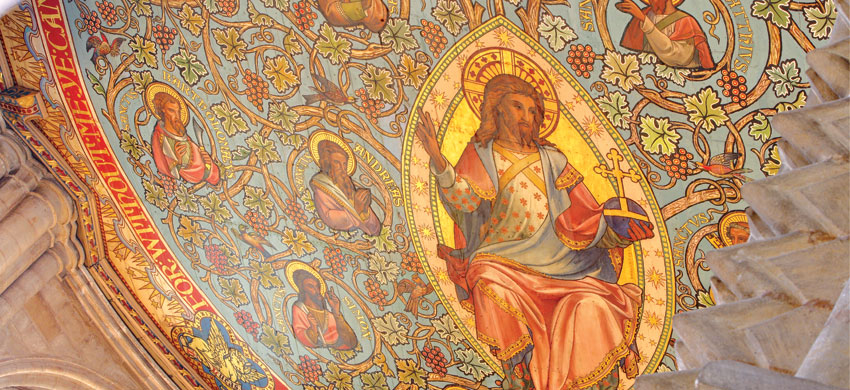 So what can people expect when they walk through the huge and ancient wooden doors, that are themselves utterly dwarfed by the magnificence of the West Front, and on into the breath-taking vastness of the cathedral itself? ‘I think they’ll find the answer to that question when they get there, because what it will do for you will vary from person to person. But at the very least, the building tells a remarkable chunk of our local and national story. I would say to the folk of Peterborough and the region that the cathedral is part of you. It’s what’s made this city what it is. And through the architecture, or the art of the ceiling, or the choral music in the background, or by the simple act of lighting a candle for a loved one, you might just discover something you have never discovered before.’
So what can people expect when they walk through the huge and ancient wooden doors, that are themselves utterly dwarfed by the magnificence of the West Front, and on into the breath-taking vastness of the cathedral itself? ‘I think they’ll find the answer to that question when they get there, because what it will do for you will vary from person to person. But at the very least, the building tells a remarkable chunk of our local and national story. I would say to the folk of Peterborough and the region that the cathedral is part of you. It’s what’s made this city what it is. And through the architecture, or the art of the ceiling, or the choral music in the background, or by the simple act of lighting a candle for a loved one, you might just discover something you have never discovered before.’
Peterborough Heritage Festival
The Heritage Festival is one of Peterborough’s biggest events and it sees the cathedral precincts come to life with over 2,000 years of living history. Visitors can mingle with Roman soldiers, Norman knights, vikings, Anglo-Saxons and even Napoleonic Redcoats as well as enjoying a medieval craft fair, archery displays, living history encampments, and a recreation of the Norman castle which once stood on top of Tout Hill in the Deanery Gardens. The festival is held on Saturday and Sunday, June 25-26.
For more information on opening times, services and events call 01733-343342,
email
or visit www.peterborough-cathedral.org.uk



